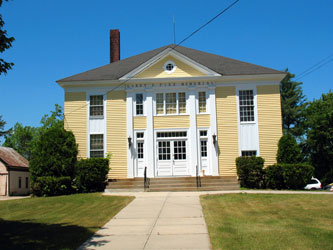
The Cornish area was on the path of the Pequawket Trail. The word “Pequawket” is believed to mean “sandy land”. The Almouchiquois (Sokokis) Indians traveled the trail seasonally between Biddeford Pool on the ocean and the Mount Washington valley in search of food. The Sokokis were members of the highly respected Tortoise Clan of the eastern Algonquins. During the 1600s French fur traders bartered with the Indians, exchanging highly prized fur pelts for blankets, beads and other handicrafts made by the tribe. The French traders respected the Native Americans and the trade arrangements worked well. The Sokokis Indians living in the area were led by chief named Captain Sandy (also called Captain Sunday).
The first white settler in the Cornish area was a fur trader named Francis Small, who operated a small trading post. He became fast, trusting friends with Captain Sandy.
In the mid-1600s the British entered the scene and upset the balance of trade enjoyed between the French and the Indians. The British were less compassionate with the Indians. The so-called Indians Wars erupted because the Indians perceived that they were being taken advantage of by the British and complained about the manner in which they were being treated. The Massachusetts-based British regarded the Indians as savages and responded to the grumbling by marching on a Sokokis fortification, which was located just across the river in Hiram, at the meeting place of the Saco and Great Ossipee Rivers. Finding no Indians there, the British burned it to the ground and proceeded to another Indian fort on Ossipee Lake in New Hampshire. Where they took a couple of prisoners and headed back to Massachusetts.
Some members of Captain Sandy’s Sokokis tribe sought to take their revenge by torching Francis Small’s home. Captain Sandy was helpless to prevent the conflagration, but he did warn his friend and Small fled to the Kittery settlement near Portsmouth. Regretting the unfortunate loss that Small had suffered, Captain Sandy decided to trade a large tract of land with Francis Small. Cornish was part of the tract of land.
During the 1700s, the village that grew up was first called Francisborough, then Cornishville. The town center was originally located on the High Road and the town was incorporated as Cornish in 1794. A stage route was established along Main Street arrived in 1846. Handsome Victorian and Colonial homes were built along Main and Maple Streets and, between the years 1850 and 1860, teams of 80 oxen moved many homes down from the High Road to where the town center is today. It took 160 oxen to haul one house over the icy Saco River from the banks of Baldwin.
Because much of the history of early Cornish was lost in a fire, all of what you read in this column was gleaned from the works of authors and researchers Addie Small, Dr. William Teg, G.T. Ridlon Sr., Michael Chaney, and the Cornish Historical Society.
*Reproduced with thanks to Cornish Association of Business.*